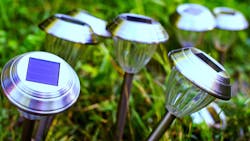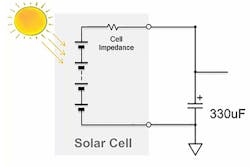The Importance of Low Iq in Energy-Harvesting Systems
This article is in TechXchange: Why Low Iq is the Smart Thing to Do
Members can download this article in PDF format.
What you'll learn:
- Wireless sensor networks used for energy harvesting.
- How energy harvesting best serves nanopower applications.
- A look at an energy-harvesting wireless switch.
Energy-harvesting-based wireless sensor networks (WSNs) are the result of enabling WSN nodes with the ability of extracting energy from the surrounding environment. There’s no one single wireless technology or standard on which WSN works. However, numerous wireless standards help in the success of WSN systems. The most popular among these are Bluetooth, ultrawideband (UWB), and Zigbee wireless standards as per IEEE 802.15.4.
What is a WSN?
The main component in any WSN network is a WSN transceiver. The transceiver houses both the RF transmitter and RF receiver. The WSN transceiver complies with any of the WSN wireless standards, one of them being IEEE 802.15.4
Low-Iq PMICs
Power-management ICs (PMICs) usually integrate many of the following: low-dropout regulators (LDOs), dc-dc regulators, sequencers, load switches, supervisors, load switches, built-in self-test (BIST) ICs, along with logic components in a single IC. These devices are easily configured with hardware and serial communications.
A PMIC needs to handle loads spanning from microamps to hundreds of milliamps and must be able to distribute power to devices employed in an energy-harvesting system. The PMIC will provide efficient system management for loads ranging from fractions of a microamp to a few hundred milliamps. It will typically operate over a 2.2- to 5-V input range.
Sleep Mode
If an energy-harvesting network becomes overly active, excess nodes must be kept in a sleep mode until it’s necessary for coverage and connectivity, especially in the event of failures in other neighboring system nodes.
Some energy-harvesting systems can draw all of their power from the surrounding environment, typically from either light or vibrational energy. Such devices could serve as platforms for running environmental or other types of sensors in remote locations.
Nanopower
Nanopower applications can make the best use of energy harvesting as their prime power source. Applications include smart homes, smart thermostats, smart locks, smart doors and windows, and even fitness bands, sports watches, and activity trackers.
Hard-to-reach remote applications will really benefit from energy harvesting. Instead of sending out a technician every month or year to replace batteries, these types of applications will now run without a battery and virtually last forever.
Most energy-harvesting components, like solar panels or piezoelectric devices, can produce only a few milliwatts (one-thousandth of a watt) or even microwatts (one-millionth of a watt) every hour. Even though small, such amounts, when banked, can power small systems due to recent improvements in lower-powered microcontrollers and transmitters. Using such self-powering systems, sensor networks could be set up where it wasn’t formerly feasible to do so in the past, due to the inability to deliver power (by replacing batteries or running a power line) to the sensors.
Even implantable medical devices in the human body can use energy-harvesting techniques. These kinds of applications run at low data rates and low duty cycles while running on nano average power.
Sources such as light, electromagnetic (EM) waves, vibrations on bridges, or even the heat generated by the human body, are viable energy sources. Light produces the most power per unit area by far. Solar-harvesting applications can sometimes use a low-Iq buck converter in the design as well.
Solar-Power Energy Harvesting
So, how can designers use solar energy to transmit via a radio?
If we have solar cells receiving sunlight and they’re arranged in series to create a higher voltage, we still will not have enough energy in those cells. The solution is to store that energy in something like a capacitor. In this way, we can now use a nanopower, low-Iq, buck dc-dc converter to create a core rail needed to power a radio IC (see figure).
Wireless Switch Using Energy Harvesting
The switch in this design is built like a linear dynamo and will transform its mechanical energy into electrical energy. This electrical energy is optimally harvested.
Since the switch is wireless and cableless, it increases the flexibility and uptime when mechanical vibration or a chemically aggressive environment might render wires impractical.
Kinetic energy is the energy generated via the motion of an object. In this case, the object is a magnet in the switch that moves back and forth inside a coil. It changes the magnetic field and induces a voltage in that coil. This principle is well known as electromagnetic induction, or Faraday’s law.
Energy-harvesting switches are quite suitable when lower maintenance and installation costs, increased flexibility, and system uptime are needed and when wiring would be impractical. These switches are a potential solution particularly in explosive-proof applications. That’s because their inherent low-power operating characteristics enable the design to avoid the usage of intrinsically safe barriers, encapsulation, or other costly protection methods.
This kind of design targets applications that require on-off signals for machine start and stop control, presence and position sensing, counting, alarm signaling, and other desired digital inputs.
In this example, a buck converter regulates the rectified and doubled signal coming from the switch, feeding the output voltage to a 32-bit Arm Cortex-M3 multiprotocol, 2.4-GHz wireless MCU with 128 kB of flash. A voltage doubler is used at the input of the buck converter to charge capacitors from the switch output voltage and switch these charges in such a manner whereby exactly twice the voltage is produced at the output than that the input. All of these devices consume very low Iq.
Summary
Engineers have harvested energy for hundreds of years, first with water and windmills, then hydroelectric dams, solar panels, and geothermal plants. Now, in today’s advanced electronics environment, engineers can use tiny solar panels and thermoelectric generators to access power from seemingly insignificant temperature differences—piezoelectric devices that convert small mechanical vibrations into power to create electricity.
The amount of power can be small—measured in microwatts—and the devices don’t usually generate power 24/7. But the ambient energy sources they use, including light, heat differentials, vibrating beams, transmitted RF signals, and others, provide that small amount of power for free. Low quiescent currents help make this possible.
Read more articles in TechXchange: Why Low Iq is the Smart Thing to Do
References
An Introduction to Wireless Sensor Networks, University of Southern California
“A 1.1nW Energy Harvesting System with 544pW Quiescent Power for Next Generation Implants,” US National Library of Medicine, NIH

